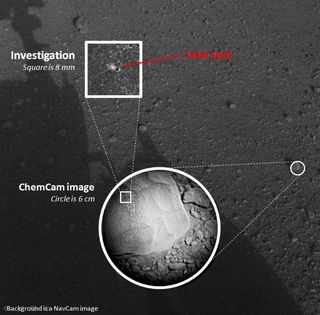Curious About Mars Life: Q&A with Astrobiologist Chris McKay

NASA's Mars rover Curiosity will use 10 science instruments over the next two years to help characterize the Martian environment and determine if the planet was ever capable of supporting life.
The Chemistry & Camera instrument, or ChemCam, blasts Martian rocks with a laser, determining their composition from the vaporized bits. ChemCam is able to resolve features five to 10 times more in-depth than previous rovers. Astrobiologist Chris McKay, based at NASA's Ames Research Center in Moffett Field, Calif., is part of the ChemCam team. He also works with the Sample Analysis at Mars instrument (SAM), the rover's onboard analytical chemistry lab.
In an interview, McKay discusses the Curiosity rover's ambitious $2.5 billion mission — officially known as the Mars Science Laboratory, or MSL — and the role ChemCam and SAM will play.
What kind of science do you generally do?
Chris McKay: My interest is in the search for organics on Mars. I've been involved in looking at organic content in desert soils on Earth as an analog for Mars. There are two deserts that I think are the best analogs for Mars — the Atacama desertin Chile and the Dry Valleys of Antarctica. [5 Bold Claims of Alien Life]

The Atacama desert in Chile is the driest desert in the world, and the Dry Valleys in Antarcticaare the coldest deserts. Since Mars is very cold and very dry, these are very relevant.
What kind of results have you had in searching for these organics on Earth?
Get the Space.com Newsletter
Breaking space news, the latest updates on rocket launches, skywatching events and more!
McKay: What we find is that, in every desert on the Earth, no matter how dry or hot or cold, there are organics present. We also find that these organics are present despite the presence of oxidants in the same soil. This suggests that the soils on Mars could have organics even if they had oxidants. That's one reason I'm optimistic that MSL will find organics in the soil on Mars.
We know that there are oxidants in the soil on Mars, and people have assumed that they would have destroyed the organics. What we're finding on Earth is that, in a dry soil, the oxidants won't destroy the organics.
What do you do specifically on Curiosity's mission?
McKay: I'm part of the SAM team, and also part of the ChemCam team.
On the SAM team, I'm involved in the analysis of the data — and the same on the ChemCam team — and discussions of what experiments and measurements to make in the future. I'm involved in the scientific analysis. I'm not involved in the technology of the instruments or the calibration of the instruments; I'm involved in the scientific analysis of the results.
For example, one thing I'll be involved in is comparing the results of the SAM analysis to what was measured by Viking many years ago on Mars, and to what we have been measuring in deserts on Earth. In terms of ChemCam, one of my interests is how to use the ChemCam laser instrument to select samples for the organic analysis by SAM. I'm a link between those two instruments.
I'm involved in all of the instruments on SAM, but my real focus is on the organic analysis of the soil. SAM does a lot of different things. I'll be a little bit involved in all of them, but my real focus and interest is the soil organics.
With ChemCam, I'm not sure what we'll be doing. One of the general goals of ChemCam is to select samples for analysis by the other instruments on the rover. In that respect, I'm trying to figure out how we can use ChemCam to select samples for SAM. We're going to learn how to do that as we get more data from ChemCam and more data from SAM. I think how to select samples for SAM using ChemCam will be a learning process.
SAM takes very small samples, a cubic centimeter or less. We don't need a lot of dirt or ground-up rock.
At this point, we are preparing to collect the first soil samples. So the rover is looking for a suitable soil to collect but we have not yet collected it.
How could your work with MSL help to answer astrobiology questions?
McKay: The question we want to know is the possibility of life on Mars. The first step is determining water; we've already done that. The next step is searching for organics, and that's the step that MSL is focusing on.
This story was provided by Astrobiology Magazine, a web-based publication sponsored by the NASA astrobiology program.
Join our Space Forums to keep talking space on the latest missions, night sky and more! And if you have a news tip, correction or comment, let us know at: community@space.com.

Nola Taylor Tillman is a contributing writer for Space.com. She loves all things space and astronomy-related, and enjoys the opportunity to learn more. She has a Bachelor’s degree in English and Astrophysics from Agnes Scott college and served as an intern at Sky & Telescope magazine. In her free time, she homeschools her four children. Follow her on Twitter at @NolaTRedd

